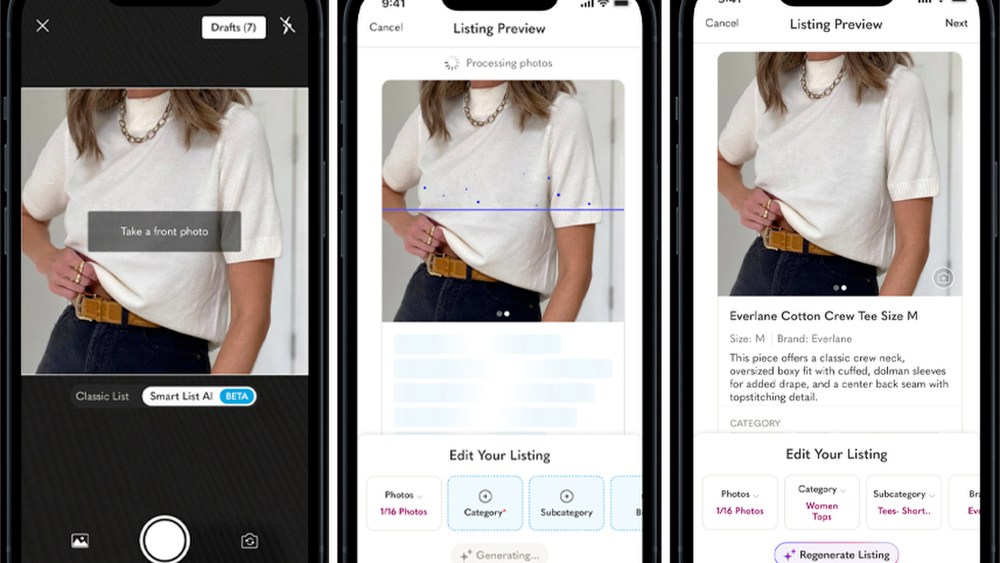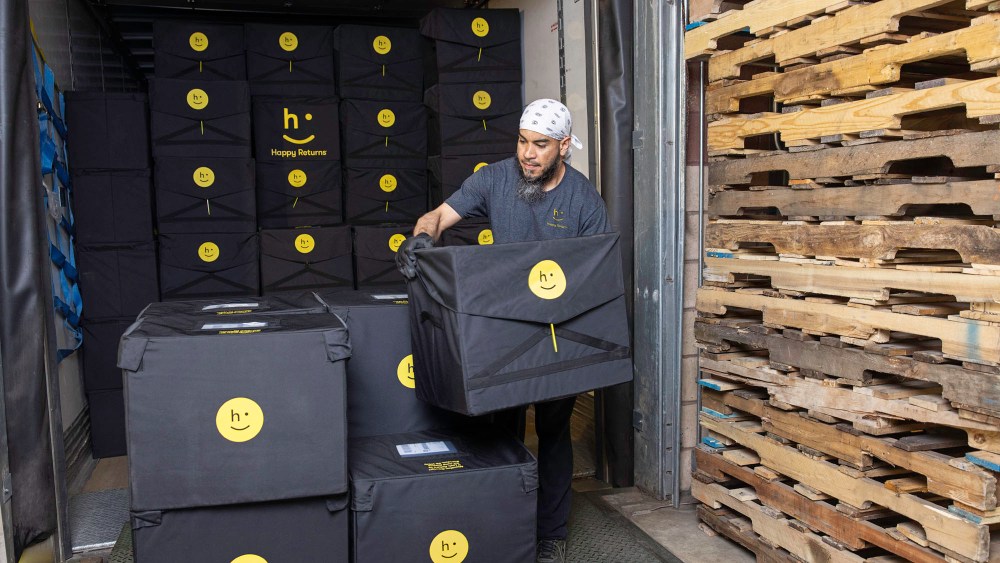
Poshmark’s newest tool aims to help sellers work smarter, not harder.
The feature, called Smart List AI, enables sellers to snap a photo of the item they want to list, then let artificial intelligence help develop a product listing page for it. That, in turn, decreases the amount of manual work necessary for the seller.
The system works in four main steps: classification, tag detection, image attribution and title and description generation.
During the classification step, Poshmark uses several AI-powered models to allow the system to understand what type of product the user has snapped a picture of — whether pants, a sweater, a purse or otherwise. The system then scans the image for visible tags, which, when found, allows it to identify further details like size or brand. From there, several models work to pinpoint specific attributes a product has, like color, sleeve length, fabric type and more. During the final step, a generative AI-powered system creates a title and description for the item.
You May Also Like
Manish Chandra, founder and CEO of Poshmark, said the finished product reads naturally and is meant to attract shoppers’ attention.
“Our engineering team has created very detailed prompts to guide the AI in crafting high-quality titles and descriptions,” Chandra explained.
Once those processes have been completed — which takes mere seconds — the seller can either edit the listing to their liking or post it without any changes. Sellers uninterested in using Smart List will still have the option of posting completely manually.
Chandra said in tests, Smart List helped sellers reduce the time they spent listing products by up to 48 percent. And among products listed with the help of the new tool, Chandra said they “sell equal or better than the normal rate.”
While its primary functions are to categorize and describe each item a seller wants to list, Smart List can also suggest a price — though Chandra said the recommended prices are based only on current, internal Poshmark data. He said the team plans to improve that function over time, likely by training the models to identify flaws like stains or fraying as well as enhancements, like high-value colorways, brand collaborations and other desirable features that drive up the price of an item on the resale market.
Chandra said he feels confident that the tool will only continue to get better with time. The more sellers use the tool, the more Poshmark receives insights into its strengths and avenues for further development.
Like any resale platform, Poshmark sellers’ goals run the gamut: some are casual sellers looking to list a few unneeded items from their wardrobe, while others sell thousands of items annually and use their accounts as a form of income. Chandra said Smart List will benefit both types.
“When you’re in the process of doing a high-volume listing flow, this [tool] can give you a huge jump start as a pro seller. For the casual seller, it really enables you to…sell more,” he explained. “This gives everyone a more level playing field, and gives all of them a huge boost to how they would merchandise their product on the platform.”
The company also anticipates the tool will make it easier for buyers to find what they seek; Chandra said it’s likely that Smart List will help increase the total number of listings on the platform, and that those listings will become more specific with AI’s assist.
The opportunity to foster stronger buyer-seller synergy — and an uptick in consumers’ interest in emerging technology — made now the right time to launch the tool, Chandra said.
“The consumer is very open to AI, and AI is ready for the consumer, so it feels like a very perfect time to bring it to the market,” he noted. “If you think about this technology, it’s almost as if it’s a copilot for the seller. So, while it’s not 100 percent automation, it gives them a huge jump start.”
Smart List is far from Poshmark’s first foray into AI.
Last year, the company launched its Promoted Closet tool, which uses machine learning to promote listings and closets, based on a weekly marketing budget set by sellers.
And in 2023, it introduced Posh Lens, which uses similar image recognition-based technology as its base and allows shoppers to use an image to search Poshmark’s assortment.
Chandra said the work is far from finished when it comes to emerging technology; while he did not disclose whether Poshmark has other specific projects in the hopper, he noted that he continues to be impressed by the speed with which AI iterates.
“The velocity will only increase,” Chandra said. “As you go forward, you see both selling and shopping get influenced [by] AI in a meaningful way. There’s so much stuff that AI can do for you that allows it to be a copilot for you, whether you’re selling or shopping. So I expect the changes to come fast and furious, and it may be a few months between changes, and it could become every month.”
To date, Poshmark has not publicly disclosed any AI-based use cases for physical systems, but Chandra said he looks forward to watching how the breakneck speed of technology allows software and hardware to work in tandem.
“Even the speed of evolution of the core AI models is increasing, so that’s really very powerful as well,” he said. “And this is still all software, so we are not talking about AI robotics that I think of as part of the future, which could be impactful for retail in our industry as well.”








